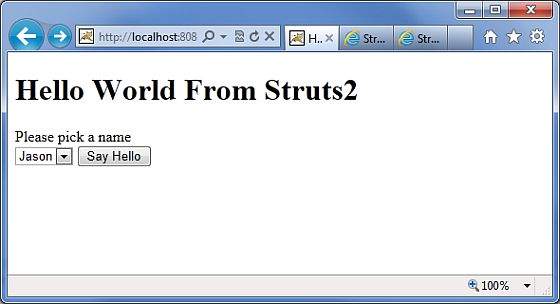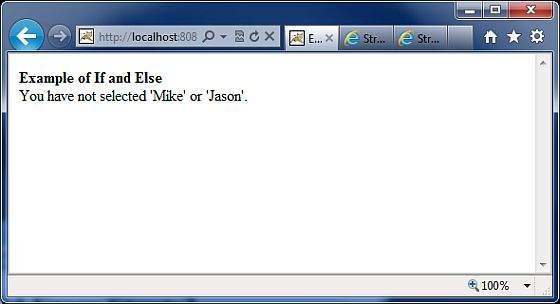检查详细示例(Check Detailed Example)
创建Action类 (Create Action Class)
package com.iowiki.struts2;
public class HelloWorldAction {
private String name;
public String execute() throws Exception {
return "success";
}
public String getName() {
return name;
}
public void setName(String name) {
this.name = name;
}
}
创建视图 (Create Views)
让我们有index.jsp文件如下 -
<%@ page language = "java" contentType = "text/html; charset = ISO-8859-1"
pageEncoding = "ISO-8859-1"%>
<%@ taglib prefix = "s" uri = "/struts-tags"%>
<!DOCTYPE html PUBLIC "-//W3C//DTD HTML 4.01 Transitional//EN"
"http://www.w3.org/TR/html4/loose.dtd">
<html>
<head>
lt;title>Hello World</title>
</head>
<body>
<h1>Hello World From Struts2</h1>
<form action = "hello">
<label for = "name">Please pick a name</label><br/>
<select name = "name">
<option name = "Mike">Mike</option>
<option name = "Jason">Jason</option>
<option name = "Mark">Mark</option>
</select>
<input type = "submit" value = "Say Hello"/>
</form>
</body>
</html>
接下来让我们使用HelloWorld.jsp来演示if, else和elseif标签的使用 -
<%@ page contentType = "text/html; charset = UTF-8" %>
<%@ taglib prefix = "s" uri = "/struts-tags" %>
<html>
<head>
<title>Example of If and Else</title>
</head>
<body>
<b>Example of If and Else</b><br/>
<s:if test = "name=='Mike'">
You have selected 'Mike'.
</s:if>
<s:elseif test = "name=='Jason'">
You have selected 'Jason'
</s:elseif>
<s:else>
You have not selected 'Mike' or 'Jason'.
</s:else>
</body>
</html>
这里,如果“test”属性中指定的条件返回true,则“if”标记返回true。 在我们的例子中,我们将其与“迈克”进行比较。 如果名称是Mike,则标记返回true并打印字符串,否则执行“elseif”块,如果不满足,则执行else块。 这与Java语言中的常规if,else if和else相同没有区别。
配置文件 (Configuration Files)
你的struts.xml看起来应该像 -
<?xml version = "1.0" Encoding = "UTF-8"?>
<!DOCTYPE struts PUBLIC
"-//Apache Software Foundation//DTD Struts Configuration 2.0//EN"
"http://struts.apache.org/dtds/struts-2.0.dtd">
<struts>
<constant name = "struts.devMode" value = "true" />
<package name = "helloworld" extends = "struts-default">
<action name = "hello"
class = "com.iowiki.struts2.HelloWorldAction"
method = "execute">
<result name = "success">/HelloWorld.jsp</result>
</action>
</package>
</struts>
您的web.xml应该如下所示 -
<?xml version = "1.0" Encoding = "UTF-8"?>
<web-app xmlns:xsi = "http://www.w3.org/2001/XMLSchema-instance"
xmlns = "http://java.sun.com/xml/ns/javaee"
xmlns:web = "http://java.sun.com/xml/ns/javaee/web-app_2_5.xsd"
xsi:schemaLocation = "http://java.sun.com/xml/ns/javaee
http://java.sun.com/xml/ns/javaee/web-app_3_0.xsd"
id = "WebApp_ID" version = "3.0">
<display-name>Struts 2</display-name>
<welcome-file-list>
<welcome-file>index.jsp</welcome-file>
</welcome-file-list>
<filter>
<filter-name>struts2</filter-name>
<filter-class>
org.apache.struts2.dispatcher.FilterDispatcher
</filter-class>
</filter>
<filter-mapping>
<filter-name>struts2</filter-name>
<url-pattern>/*</url-pattern>
</filter-mapping>
</web-app>
右键单击项目名称,然后单击“ Export 》 WAR File以创建War文件。 然后在Tomcat的webapps目录中部署此WAR。 最后,启动Tomcat服务器并尝试访问URL http://localhost:8080/HelloWorldStruts2/index.jsp 。 这将产生以下屏幕 -

现在选择“标记”并提交页面。 你应该看到下一页。

